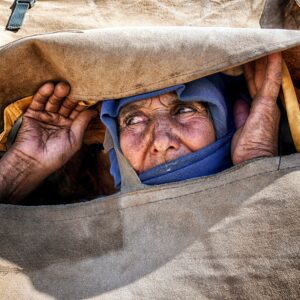Documentary photography goes beyond mere imagery; it represents powerful storytelling, deep inside the documentation of events and real experiences that touch various social issues of the world. We will navigate the world of documentary photography; explore its meaning, historical antecedents, styles, techniques, and more importantly, influence on society; insights for wannabe documentary photographers on how they can effectively present stories through the lenses.
Documentary Photography
Documentary photography is essentially the act of taking pictures that represent reality, unmanipulated and unstaged. It is about documenting events, environments, and people in a way that tells a story or conveys a message about the world. It is different from other forms of photography that focus on aesthetics or artistic expression. Documentary photography is about authenticity and truthfulness.

Photo by Frances Barcelo on Unsplash
Characteristics of Documentary Photography
Authenticity: Documentary photography aims to present subjects in their natural state, without interference, capturing real moments. Authenticity will make the audience connect with the subject matter at a deeper level. For example, a family photo taken in their home during a hard time may bring about sympathy and understanding that a staged photo might not do.
Narrative: Each photograph in a documentary series contributes to a broader narrative. Photographers often work on projects that explore specific themes or issues over time, creating a cohesive story through their images. A series documenting the life of street vendors can illustrate not just their daily struggles but also their resilience and community ties.
Social Commentary: Many documentary photographers aim to expose social issues, injustices, or cultural phenomena. Their work often becomes a catalyst for change by raising awareness and encouraging discussions. For instance, the work of photographers such as Sebastião Salgado has brought global issues like migration and environmental degradation into the spotlight.
Historical Record: Documentary photography also plays a key role in recording history. What is photographed today will be there for future generations to see; it will reveal the life of today. These photographs taken on the day of historical events, be it protests or natural disasters, become invaluable for historians and teachers.
Documentary photography’s roots date back to the 19th century, when photographers used their cameras to document social issues and historical events. One of the pioneers in this genre is Jacob Riis, whose work in the late 1800s highlighted the living conditions of the urban poor in New York City. His book “How the Other Half Lives” made use of photographs to expose societal inequalities and push for reform.
As photography technology grew, so did the range of documentary photography. Portable cameras let photographers capture more spontaneous moments from everyday life. During the Great Depression, there were photographers like Dorothea Lange who actually documented the challenges of displaced families, which helped create some images that still seem to speak well today.
Key Figures in Documentary Photography
Dorothea Lange: Best known for her photograph “Migrant Mother,” Lange’s work during the Great Depression humanized the plight of impoverished families and brought attention to their struggles. Her ability to capture raw emotion made her images timeless representations of hardship.

W. Eugene Smith: Although best known for their photo essays, Smith’s works are associated with a number of social issues and human rights. His series “Country Doctor” offered an intimate look at life in the rural community of a physician, revealing not only dedication but also the challenges of the rural population.

Garry Winogrand: He is one of the major figures in street photography. The candid images by Winogrand captured the energy and chaos of American life during the mid-20th century. His works reflect everyday moments that reveal deeper truths about society.

Sebastião Salgado: A Brazilian photographer known for his stunning black-and-white images documenting social issues around the world. His works like “Workers” and “Genesis” highlight both human struggle and environmental beauty.
Documentary Photography

Types of Documentary Photography
Documentary photography is very diverse and encompasses many styles and approaches, each with its unique focus:
1. Social Documentary Photography

Photo by Marjan Taghipour on Unsplash
This style focuses on social issues and aims to promote change by pointing out injustices and inequalities within communities. Photographers often interact with their subjects to create powerful narratives that inspire action. For instance, photojournalists covering refugee crises try to humanize statistics by focusing on individual stories.
2. War Documentary Photography

Photo by The Australian War Memorial on Unsplash
War photographers photograph war regions and the human life in a war-torn conflict area. These photographs do not only portray the fracas of war but depict its aftermath, which demonstrates how war impacts civilians and communities when fighting is no longer happening. Famous war photographers include James Nachtwey, who risked their lives for the exposure of barbarisms that take place in the world.
3. Environmental Documentary Photography

Photo by Baptiste Buisson on Unsplash
This category revolves around environmental concerns, including climate change, conservation, and habitat destruction. Photographers try to raise awareness of ecological challenges by capturing compelling images that are both beautiful and devastating. Projects such as Chris Jordan’s “Midway” depict plastic pollution on wildlife while creating emotional responses from the viewer.
4. Cultural Documentary Photography

Photo by Marjan Taghipour on Unsplash
Cultural documentary photography includes capturing traditions, rituals, and lifestyles within a particular community. It aims at diversity and has knowledge about most of the different cultures in this world. Steve McCurry has given a very dynamic view of these people by bringing alive their pictures with stories. Techniques for Successful Documentary Photography
Capturing compelling documentary photographs requires more than technical skills; it requires an understanding of your subjects and telling their stories authentically. Here are some essential techniques:

Photo by Billy Freeman on Unsplash
1. Be a Photographer, Not a Director
One of the basic tenets of documentary photography is not to stage or direct scenes. You should instead shoot moments as they happen. In this way, you can speak to real emotions and interactions-for example, catching laughter between family members during an ordinary meal says much more than a posed portrait could ever say.
2. Form Relationships with Your Subjects
Build a rapport with your subjects to take authentic moments. Take time learning about them, and this way, you’ll be able to gain their trust and make them comfortable in front of your camera. For instance, spending weeks with a community before photographing them can lead to deeper connections reflected in your images.
3. Research Your Subject Matter
Before embarking on a documentary project, conduct thorough research about your subject matter—understanding cultural contexts or historical backgrounds will enable you to approach your work with sensitivity and depth.
4. Embrace Candid Moments
Documentary photography thrives on spontaneity; be prepared to capture unexpected moments that tell powerful stories—even if they are picture-perfect compositions! Sometimes it’s those unplanned shots that resonate most deeply with viewers.
5. Use Natural Light
Natural light could enhance the mood and realism of photographs, and varied times of day could uncover optimal lighting conditions for the subject matter at hand—this can make a critical difference between scenes conveying emotions or not.
6. Create a Narrative Arc
When shooting long-term projects, think about how each photograph contributes to an overarching narrative arc—think about sequencing images so they create compelling stories that engage viewers emotionally over time!
7. Edit Thoughtfully
While documentary photography emphasizes authenticity, thoughtful editing can enhance storytelling without compromising integrity! Focus on selecting images that best represent narratives while maintaining honesty—this might mean leaving out certain photos if they don’t serve overall goals effectively!
Impact of Documentary Photography

Photo by Abhyuday Majhi on Unsplash
Documentary photography holds deep meanings for society:
Creating Awareness: Iconic images can draw attention to important social causes that otherwise might not gain media attention; imagine how images of protests have mobilized public opinion on causes like racial justice or climate action!
Creating Compassion: Documenting real life documentary photographers instill a sense of empathy in the viewers-by making them relate to subjects emotionally rather than merely viewing them from a distance.
Preserving History: Documenting contemporary life ensures future generations have access visual records reflecting societal values challenges; these photographs become vital historical artifacts!
Inspiring Change: Many documentary projects aim inspire action highlighting injustices advocating social change empowering viewers get involved meaningful ways! Consider how iconic images from civil rights movements galvanized support across diverse communities!
Challenges Faced by Documentary Photographers
While documentary photography is rewarding it also comes with its challenges:
Ethical Dilemmas of Photography: Capturing vulnerable groups, individuals. Representation, Exploitation. Understanding cultural sensitivity, respect for privacy are musts!
Access & Safety: It is very challenging to obtain access to areas, especially areas in conflict zones. Photographers seek authentic stories while ensuring their personal safety by respecting local customs and laws
Emotional Impact: Photographing challenging subject matter can be emotionally draining for photographers who see suffering injustice firsthand; finding ways to cope with processing these experiences in a healthy manner is crucial!
Funding & Support: Many documentary projects are grant-dependent or crowdfunded, and securing funding can be difficult in competitive fields; building relationships with organizations and foundations interested in supporting social causes may help alleviate some of the financial burdens!

Photo by Firdous Parray on Unsplash
Conclusion
Documentary photography is the art of real storytelling through photography, transcending time space; it speaks of real issues at hand that audiences can connect to. In such a case, photographers become more than mere visual recorders in documenting the usual social issues or cultural practices to historical events
As we step into an increasingly visual culture dominated by digital media, importance authentic storytelling through documentary photography remains paramount! It serves as call aspiring photographers engage deeply subjects while remaining committed truthfulness—a powerful reminder every photograph has potential impact lives inspire change!
By embracing this art form’s rich history diverse techniques photographers can continue capturing compelling narratives reflect humanity’s complexities fostering empathy understanding within society at large!
In this era where visual storytelling is more accessible than ever before—thanks smartphones social media platforms—everyone has opportunity not only consumers but also creators contribute unique perspectives through lenses! Whether you’re experienced photographer just starting out—remember: every moment holds significance waiting patiently behind camera! This expanded blog now offers a more comprehensive exploration of documentary photography as well as the practical suggestions for aspiring photographers who wish to have some impact on what they do. If further elaboration is needed, or even certain sections shouldered even more deeply (such as case studies or personal anecdotes), feel free to ask!





